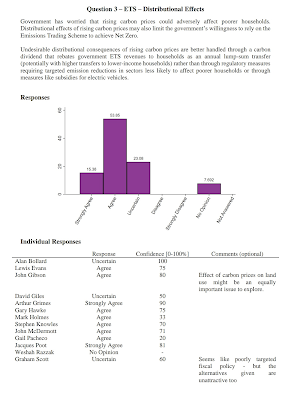Government legislated for net-zero by 2050. That's a target - a destination. Not a path for getting there.
Economists are broadly of the view that prices can guide us to that target. Set a declining cap on the ETS to get to net-zero and let prices and anticipated prices provide the signal of the best path to take. Prices adjust; the cap binds.
There's fiddly stuff around how the legislation works. Government wants to hit annual emission budget targets and that makes things more complicated. You can buy and store credits, and redeem them whenever you want.
But none of that really matters if what you care about is a sharply declining net emissions path to 2050 and maintaining net-zero thereafter. Take net current emissions. Put a dot on the chart. Set net emissions to zero at 2050. Draw a line between the points. I don't care whether you want to make it linear, concave, convex, whatever. Take the area under the curve above the x-axis. Announce "This is the total volume of credits that the government will auction between now and 2050, and here's the annual path for our auctions. Do what thou wilt."
Does it matter then if somebody buys a pile of credits now to use later? No. The area under the curve is the area under the curve, and the binding cap binds. If you overshoot the annual emission budget in one year it will necessarily be because you've undershot it in another year. Actual redemptions will wind up either being concave, convex, linear or whatever as emergent property. The total volume is fixed. The shape that the curve in redemptions takes will be driven by a big complicated mix of stuff that the government is best not worrying about. It'll reflect expectations around tech and cost changes over the period.
People tie themselves up in knots about how maybe the ETS has a soft cap because credits can move from year to year. But none of that affects net emissions between now and 2050 unless government does something stupid like increase the volume it puts up to auction in later years in response to current stockpiling.
There are tons of potential paths between here and 2050. I'm sure not wise enough to be able to say "This! This is the best path! And here is the number of doctors we will need each year from now until 2050, and the number of bakers, and the number of bus drivers...." 5-year plans don't work and 30-year plans will be even worse. Set the target and let people choose their paths to get there.
Olivia Wannan has a column up. She casts me and Matt Burgess as being on one side, with all the environmentalists on the other.
Of course, the survey of economists within the past month had nobody really disagreeing with us. Use the ETS to deal with carbon; if there are other policy objectives, use other policy instruments to deal with them; use a carbon dividend to offset distributional consequences.


Burgess uses the commission’s work to argue “existing policies already have New Zealand on track to deliver net-zero emissions by 2050”. Therefore, further efforts to tackle gross emissions may be unnecessary and expensive, he argued.However, in the commission’s scenario, achieving net-zero in 2050 isn’t permanent. By 2065, planted forests would come up for harvest and net emissions would spike up.This would violate the Act, which requires all budgets after 2050 to also achieve net zero.
... Asked about the option to front-foot gross emissions cuts to prevent the bump from 2065, Crampton says that the country could – at that point – decide its cheapest available option. This could be further gross emissions cuts, more trees, or new tech such as carbon removal.
“It seems a mistake to require substantial reductions in gross emissions now and over the next decade, in case of reductions in forestry sequestration a half a century from now…. [It] is a large bet that none of the technologies under development will wind up being able to sequester carbon at any reasonable price.”

